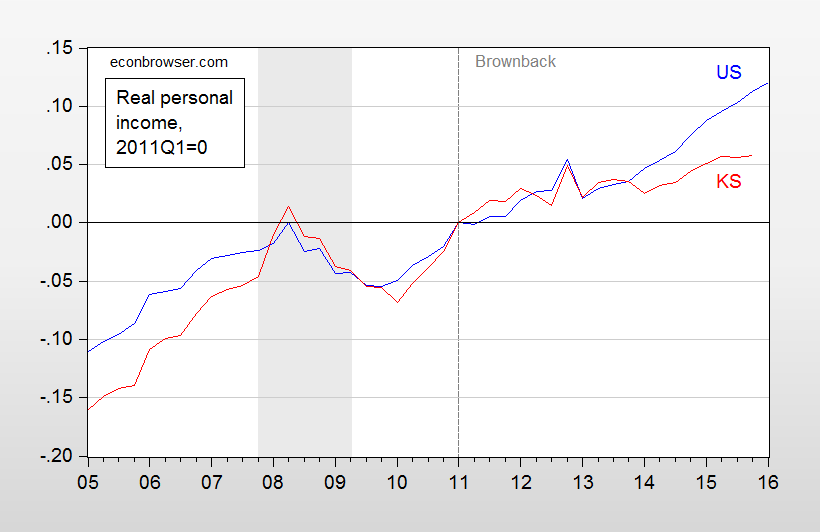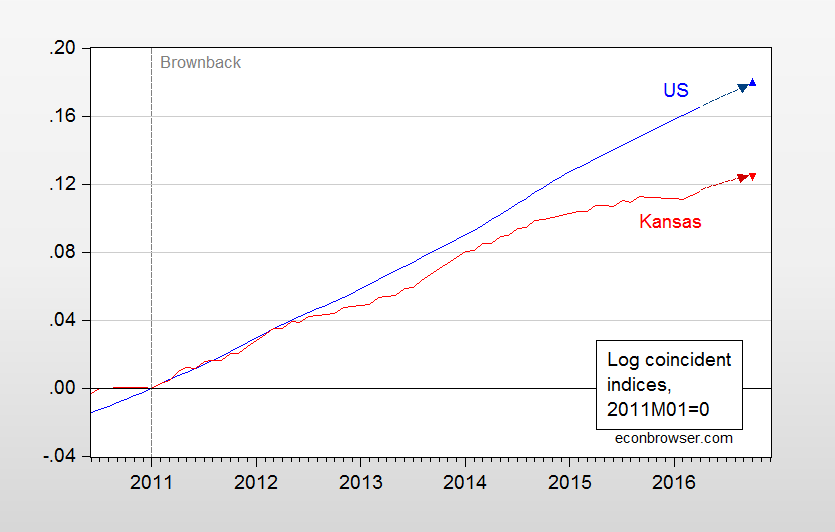With Philadelphia Fed leading indices out, I still don’t know if it constitutes a “disaster”, but it’s not particularly good.
While we have state GDP only up to 2015Q3 (2015Q4 figures to come out in mid-June), we do have personal income statistics through 2015Q4. The national and Kansas figures, deflated using the national personal consumption deflator, are shown in Figure 1.
Figure 1: Log personal income for US (blue), and for Kansas (red), both deflated using national personal consumption deflator, both normalized to 2011Q1. NBER defined recession dates shaded gray. Source: BEA, NBER and author’s calculations.
Astute observers will note Kansas real personal income was rising faster than national income before the Great Recession, and is rising more slowly, particularly since mid-2013. (GDP figures, and a counterfactual, are shown in this post.)
What are the prospects for Kansas. The Philadelphia Fed published leading indicators today. They indicate Kansas will continue to lag.
Figure 2: Log coincident index for US (blue), and for Kansas (red). Implied levels for October 2016 are based on leading indicators. Source: Philadelphia Fed, and author’s calculations.
For a graph depicting the trajectory of Kansas and her neighbors, see this post.


Perhaps Figure 1 could be interpreted in a slightly different way….
Kansas income trailed the U.S. until the mid-00s when sections of the U.S. (like Michigan under Democratic Governor Jennifer Granholm elected in 2002) began to experience severe economic stagnation. Kansas did not experience as severe a decline as the U.S. in general so it appeared that Kansas was actively gaining instead of the U.S. actively losing. When the recovery began, the U.S., in general, started to return to normal income growth which had been faster than Kansas and once again became faster than Kansas which plods along in its history fashion.
Of course, that’s just another narrative, but I’m guessing there is a kernel of truth in that. It would be interesting to have a look further back.
Bruce Hall: Just plotted the series. I don’t think your narrative works. Normalized to 1990Q1, Kansas matches the US until end-1998, and starts lagging thereafter. Catches up in mid-2008, and then lags during the Great Recession. By 11Q3, the two are within a percentage point before the gap widens to 7% by 2015Q4.
Menzie, okay, thanks. It’s good to have the larger picture.
The real income data shows Kansas above the US at the economic peak and below the US at the bottom. This strongly implies that Kansas fell more than the US in the great recession. OK, Bruce what evidence do you have that this is misleading?
If you read what I wrote, you may be able to discern the interpretation. But I’ll help you. If two sets are increasing and then one begins to rise more slowly before they both fall, you can interpret it two ways: the faster rising set is accelerating versus the other or the slower rising set is failing before the other. Menzie answered the question by going back further with the data>>>
Normalized to 1990Q1, Kansas matches the US until end-1998, and starts lagging thereafter. Catches up in mid-2008, and then lags during the Great Recession. By 11Q3, the two are within a percentage point before the gap widens to 7% by 2015Q4.
Kansas was lagging the U.S. until a few years before the recession when the U.S. economy and incomes rose more slowly/fell faster than Kansas. During the recession, Kansas income fell faster than the U.S. (but not significantly) and then pretty much tracked the U.S. until 2013 when Kansas income stopped growing and U.S. income rose.
So, something happened to flatten Kansas income and create a gap similar to 2005 (which was an economic high point for the U.S. economy). Perhaps Kansas’ potential income growth is simply not as great as the U.S. because of demographics, industry mix, or politics; but tends not to fall as fast/far in bad times. I don’t know why Kansas should have been so far behind the U.S. in 2005 during a good economic period and again in 2015 when the economy was again in a relatively good period. Perhaps you or Menzie can explain that phenomenon.
Professor Chinn,
In case Mr. Brownback is reading this blog, what would you advise him to do as his economic advisor to reverse the continuing lag indicated by the Philadelphia Fed.? He may take your advice.
I highly doubt he would make the changes necessary. It’s obvious his and Art Laffer’s (and ALEC’s) plan to make Kansas a rich state is a failure. The powers that be have far too much invested in proving their supply-side dogma to admit defeat and come up with a new plan. It’s sad because certain conservative movements are very helpful to growth. Things like removing occupational licensing and streamlining business and capital formation can be a huge benefit to any economy, no matter the state. Unfortunately, rather than put resources towards things that will assist Americans, the right continues to bludgeon an economic strategy peddled by economic clowns.
The good times here in Kansas just keep rolling on: May tax collections were almost $75 million below the projected amount (a projection that was lowered in April); the state budget for FY 2016 is about $50 million in the red, and the state Legislature has given Brownback the power to cut the budget as he sees fit. Most likely to be cut: Medicaid and programs aimed at aiding children living in low-income homes.
http://www2.ljworld.com/news/2016/jun/01/kansas-revenues-fall-745-million-short-may/
Meanwhile, the Kansas Supreme Court last Friday ruled that the way the state funds public K-12 education is unconstitutional and said it would order the state’s schools to close on July 1 if the Legislature did not correct the funding mechanism. Yesterday was the last day of the 2016 Legislative session. The Legislature did nothing to correct the education budget — and several Republican legislators said they want to defy the court order — but they did issue a resolution condemning the federal government’s directive on the transgender bathroom issue.
http://www2.ljworld.com/news/2016/jun/01/kansas-lawmakers-drop-push-pass-new-school-funding/
In terms of unemployment, Kansas looks good by comparison with Minnesota.
In April 2015, the respective unemployment rates of Minnesota and Kansas were 3.7 (3rd best) and 4.3% (11th place). A year later, Minnesota’s unemployment rate has actually risen, to 3.8%, now tied with Kansas (both 11th). By this measure, Kansas looks quite good, a reduction in unemployment rate by 0.5 pp. Minnesota, while still strong in absolute rates, has fallen substantially in relative terms.
What’s wrong with Minnesota?
http://www.ncsl.org/documents/employ/STATE-UI-RATES-2015.pdf
http://www.bls.gov/web/laus/laumstrk.htm
Steven Kopits: Well, remember the unemployment rate is the ratio of two series (both very imprecisely measured at the state level). The Minnesota labor force has jumped up in recent months. Kansas labor force is shrinking, in contrast.
One of those reasons not to pay too much attention at state-level unemployment rates.